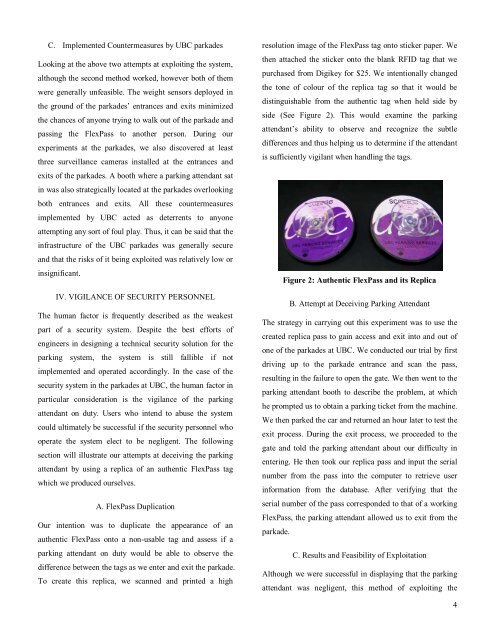EECE 412 Term Project Report - Group 3 - Courses - University of ...
EECE 412 Term Project Report - Group 3 - Courses - University of ...
EECE 412 Term Project Report - Group 3 - Courses - University of ...
Create successful ePaper yourself
Turn your PDF publications into a flip-book with our unique Google optimized e-Paper software.
C. Implemented Countermeasures by UBC parkades<br />
Looking at the above two attempts at exploiting the system,<br />
although the second method worked, however both <strong>of</strong> them<br />
were generally unfeasible. The weight sensors deployed in<br />
the ground <strong>of</strong> the parkades’ entrances and exits minimized<br />
the chances <strong>of</strong> anyone trying to walk out <strong>of</strong> the parkade and<br />
passing the FlexPass to another person. During our<br />
experiments at the parkades, we also discovered at least<br />
three surveillance cameras installed at the entrances and<br />
exits <strong>of</strong> the parkades. A booth where a parking attendant sat<br />
in was also strategically located at the parkades overlooking<br />
both entrances and exits. All these countermeasures<br />
implemented by UBC acted as deterrents to anyone<br />
attempting any sort <strong>of</strong> foul play. Thus, it can be said that the<br />
infrastructure <strong>of</strong> the UBC parkades was generally secure<br />
and that the risks <strong>of</strong> it being exploited was relatively low or<br />
insignificant.<br />
IV. VIGILANCE OF SECURITY PERSONNEL<br />
The human factor is frequently described as the weakest<br />
part <strong>of</strong> a security system. Despite the best efforts <strong>of</strong><br />
engineers in designing a technical security solution for the<br />
parking system, the system is still fallible if not<br />
implemented and operated accordingly. In the case <strong>of</strong> the<br />
security system in the parkades at UBC, the human factor in<br />
particular consideration is the vigilance <strong>of</strong> the parking<br />
attendant on duty. Users who intend to abuse the system<br />
could ultimately be successful if the security personnel who<br />
operate the system elect to be negligent. The following<br />
section will illustrate our attempts at deceiving the parking<br />
attendant by using a replica <strong>of</strong> an authentic FlexPass tag<br />
which we produced ourselves.<br />
A. FlexPass Duplication<br />
Our intention was to duplicate the appearance <strong>of</strong> an<br />
authentic FlexPass onto a non-usable tag and assess if a<br />
parking attendant on duty would be able to observe the<br />
difference between the tags as we enter and exit the parkade.<br />
To create this replica, we scanned and printed a high<br />
resolution image <strong>of</strong> the FlexPass tag onto sticker paper. We<br />
then attached the sticker onto the blank RFID tag that we<br />
purchased from Digikey for $25. We intentionally changed<br />
the tone <strong>of</strong> colour <strong>of</strong> the replica tag so that it would be<br />
distinguishable from the authentic tag when held side by<br />
side (See Figure 2). This would examine the parking<br />
attendant’s ability to observe and recognize the subtle<br />
differences and thus helping us to determine if the attendant<br />
is sufficiently vigilant when handling the tags.<br />
Figure 2: Authentic FlexPass and its Replica<br />
B. Attempt at Deceiving Parking Attendant<br />
The strategy in carrying out this experiment was to use the<br />
created replica pass to gain access and exit into and out <strong>of</strong><br />
one <strong>of</strong> the parkades at UBC. We conducted our trial by first<br />
driving up to the parkade entrance and scan the pass,<br />
resulting in the failure to open the gate. We then went to the<br />
parking attendant booth to describe the problem, at which<br />
he prompted us to obtain a parking ticket from the machine.<br />
We then parked the car and returned an hour later to test the<br />
exit process. During the exit process, we proceeded to the<br />
gate and told the parking attendant about our difficulty in<br />
entering. He then took our replica pass and input the serial<br />
number from the pass into the computer to retrieve user<br />
information from the database. After verifying that the<br />
serial number <strong>of</strong> the pass corresponded to that <strong>of</strong> a working<br />
FlexPass, the parking attendant allowed us to exit from the<br />
parkade.<br />
C. Results and Feasibility <strong>of</strong> Exploitation<br />
Although we were successful in displaying that the parking<br />
attendant was negligent, this method <strong>of</strong> exploiting the<br />
4
















